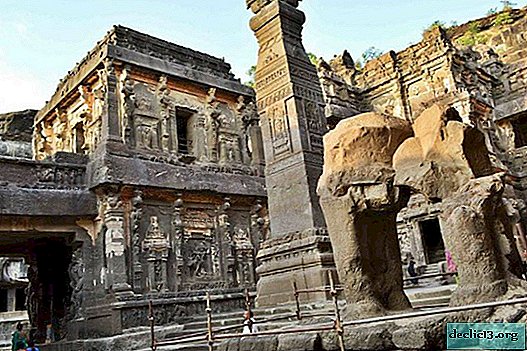Ellora - one of the most interesting cave temples of India
Ellora, India - a small commercial village, which, perhaps, would have remained unknown to anyone, if not for the unique cave temples, carved directly in the rocks. Being a real standard of ancient Eastern religious architecture, they impress with their grandeur and incomparable atmosphere.

General information
Black caves of Ellora, created in the period from 6 to 9 centuries. n e., located in the village of the same name in Maharashtra (central part of the country). The place for their construction was not accidental, because in ancient times, exactly at this point, located near Ajanta, numerous trade routes converged, attracting merchants and travelers from around the world. It was on their taxes that this complex was built, or rather, it was carved in the strongest rock.
The building, testifying to the tolerant attitude of Hindus to representatives of other faiths, consists of a number of temples, divided into 3 groups - Buddhist, Jain and Hindu. For the convenience of tourists, scientists and guides, they are all numbered in the order of construction - from 1 to 34.
From west to east, a mountain in which the unique Ellorian caves are carved cross four rivers. The largest of them, Elaganga, forms a powerful waterfall that appears here only during the rainy season.

Scientists studying the cave temples of Ellora were never able to find any scientific evidence of how exactly one of the most unusual religious buildings in India was built. Most of the theories that currently exist are based on information taken from ancient manuscripts and copper tablets. It was with their help that it was possible to establish that the Ellor caves began to turn into temples in about 500 AD. e., when the monks who fled from Ajanta moved to this area.
Today, temples, which, despite the centuries-old period of their existence, are in excellent condition, are included in the UNESCO World Heritage List and are under state protection. Nowadays, according to sculptures, bas-reliefs and cave paintings carved on their walls, you can study Indian culture, mythology and history.
Complex structure
It will take more than one day to get acquainted with the numerous temples of Ellora in India. If you have only a few hours at your disposal, get acquainted with the structure of this complex in absentia - this will allow you to make the most optimal route.
Buddhist temples
Buddhist halls, from which, in fact, the construction of this grand attraction began, are located in the southern part of the complex. There are 12 of them in total - and all but one are vihars, small monasteries used for meditations, teachings, religious rituals, nights and lunches. The main feature of these caves is the sculptural image of the Buddha sitting in different poses, but always looking east, towards the rising sun. Impressions from Buddhist monasteries remain ambiguous - if some of them are clearly unfinished, then in others there are as many as 3 floors and a huge number of all kinds of statues.
To get to this part of the complex, you need to overcome a narrow staircase that goes underground for about 20 m. At the end of the descent, Tin-Thal, the central Buddhist temple of Ellora, opens to the eyes of visitors. The three-story statue, considered one of the largest cave sanctuaries in the world, looks extremely simple: three rows of square columns, narrow entrance gates and monumental basalt platforms decorated with rare carved patterns. Tin-Thal itself consists of several spacious halls, in the twilight of which majestic basalt sculptures shine.

The Rameshwara Buddhist monastery, present in many tourist photos of Ellora in India, is no less delightful. Yielding to the central building in area and size, it far surpasses it in the richness and beauty of the interior design. Each centimeter of this building is decorated with thin carvings resembling human hands frozen in a terrible tension. The vaults of Rameshvar are supported by 4 columns, the upper parts of which are made in the form of large female figures, and the lower ones are decorated with high reliefs on the theme of Indian mythology. Inside the temple there are many fantastic creatures that surround the incoming from all sides and evoke a genuine sense of fear on him. The ancient masters managed to convey the plasticity of movements so precisely that the images of gods, people and animals that adorn the walls of the cave look like alive.
17 Hindu caves, located on the top of Mount Kailash, are a huge monument carved from a monolithic rock. Each of these shrines is good in its own way, but only one arouses the greatest interest - this is the Kailasanath temple. Considered the main pearl of the whole complex, it impresses not only with its size, but also with its unique construction technology. The huge sanctuary, the height, width and length of which is 30, 33 and 61 m, respectively, was carved from top to bottom.

The construction of this temple, which lasted as much as 150 years, took place in stages. First, the workers hollowed out a deep well, removing at least 400 thousand tons of rock. Then, numerous stone carvers created 17 moves leading to large halls. At the same time, the masters began to create arches and cut out additional rooms, each of which was intended for a particular deity.
The walls of the Kailasanatha temple in Ellora, which is also called the "top of the world", are almost completely covered with bas-reliefs showing scenes from the scriptures. Most of them are connected with Shiva - it is believed that the supreme god of Hinduism was sitting on this very mountain. Patterns and drawings on closer inspection seem voluminous. This is especially noticeable at sunset, when numerous shadows appear from the figures carved in stone - it seems as if the picture is gradually coming to life and slowly moving in the rays of the setting sun.

Scientists believe that such a visual effect was invented on purpose. Unfortunately, the name of its author has remained unknown, but the fact that the same architect worked on the project of the Hindu caves does not raise doubts, this is indicated by a copper tablet found in one of the hiding places.
Due to the specific composition of the rock, the Kailasanatha Temple in Ellora (India) has not changed much since its foundation. Moreover, in some places you can notice traces of white paint, which gave these caves a resemblance to snow-capped mountain peaks.Find out RATES or book any accommodation using this form
Jain TemplesThe last, the youngest caves of Ellora, are located in the northern part of the complex. About 2 km separates them from the rest of the buildings, so many tourists do not reach here. There are five Jain temples in total, but only one is completed. For unknown reasons, work on the construction of the largest Indian shrine suddenly stopped, although the Jain cult at that time experienced the greatest peak of its development.
Jain cave temples, decorated with carvings and graceful bas-reliefs, are dedicated to three gods - Gomateshvar, Mahavir and Parshvanatha. In the first of them you can see a nude statue of a deity immersed in a deep meditative state - his legs are entwined with vines, and at the base of the statue itself you can see images of spiders, animals and reptiles.

The second cave, dedicated to the founder of Jain philosophy, is decorated with sculptural images of formidable lions, huge lotuses and Mahavir himself. As for the third, which is a reduced copy of the Shaivite temple, only the remains of the ceiling painting remained in it, causing great interest both among professional art critics and ordinary visitors.
Useful Tips
When planning to visit the Ellora Caves in India, read the recommendations of those who have already visited there:
- At the entrance to the complex, many monkeys frolic, for which it costs nothing to grab a camera or camcorder from the gape of a tourist, so all more or less valuable things should be kept stronger.
- In many caves there is twilight - be sure to bring a flashlight with you, because without it you simply won’t see anything.
- Walking through the halls, do not forget about the basic rules of behavior. If for Europeans this is just an interesting tourist attraction, then for Indians it is a sacred place. For any violation you will be taken outside without even giving anything to explain.
- When planning a trip to the stone temples, do not forget to check the schedule of their work (cf. Mon. from 07:00 to 18:00).
- It is better to start acquaintance with one of the main attractions of India with Kailasanatha. You need to come directly to the opening, because by 12 o’clock there will not be crowded here.
- If you plan to spend at least a few hours in the caves, bring a couple of bottles of mineral water with you. Despite the abundance of stone, it is very hot here, and water is sold only at the entrance.
- Do not even try to take a couple of stones as a keepsake - this is prohibited here. There are plenty of guards in the complex, and it is almost impossible to distinguish them from guides or local residents.
- Do not settle for a selfie with the locals - take a picture with at least one of them, you will fend off the rest for a long time.
- Ellora (India) is famous not only for its unique temples, but also for its rich cultural and entertainment program. So, in early December, a festival of music and dance is held here, which attracts a huge number of people. Naturally, in between performances, they all rush to the ancient caves, which already do not suffer from a lack of tourists.
- It offers 2 dining rooms and many toilets, but the best is at the entrance.


Full overview of Ellora's Caves (4K Ultra HD):

















